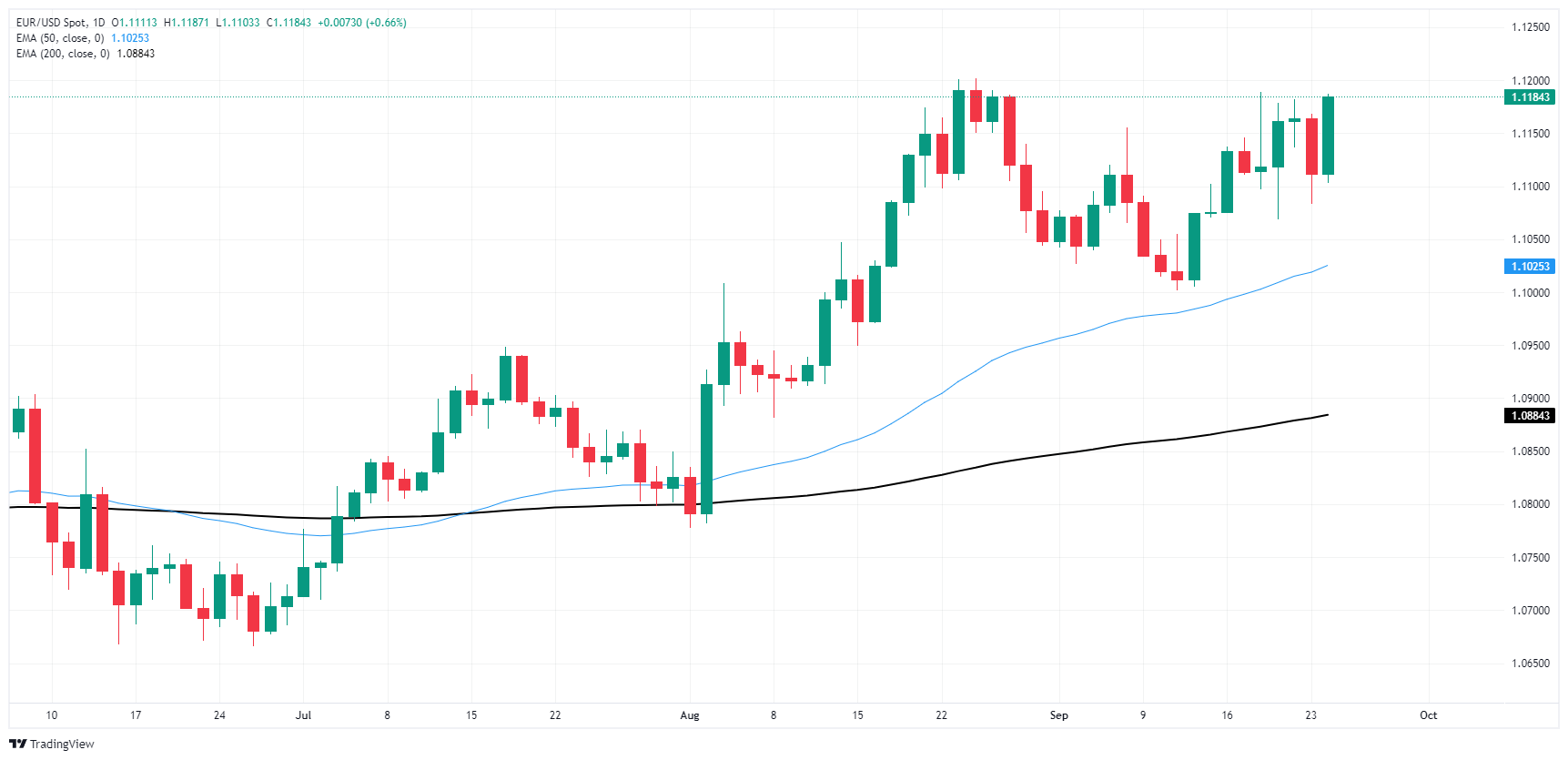EUR/USD recovers ground on Greenback weakness
- EUR/USD found its footing on Tuesday, recovering the early week’s lost ground.
- Markets have tilted into a short-USD stance on rising hopes for more rate cuts.
- Wednesday sees a notable lull in economic data for both sides of the Fiber.
EUR/USD cut away bearish sentiment and rallied back into recent highs on Tuesday, taking another unsuccessful run at 1.1200. The Euro itself has little reason to be bid up by traders, but a broad-market weakening in the Greenback is helping to keep Fiber bidding action on the high side.
There is little data of note due on Wednesday on both sides of the Atlantic. Euro markets are entirely absent from the economic docket for the midweek market session. USD traders will have to wait until the NY market session before an appearance from Federal Reserve (Fed) Board of Governors member Adriana Kugler, who will be speaking at the Harvard Kennedy School in Cambridge.
Consumer confidence deteriorated across the board on Tuesday, and consumer expectations of 12-month inflation accelerated to 5.2%. Consumers also reported a general weakening of their six-month family financial situation outlook, and consumer assessments of overall business conditions have turned negative.
As explained by the Conference Board’s chief economist Dana Peterson, “Consumers’ assessments of current business conditions turned negative while views of the current labor market situation softened further. Consumers were also more pessimistic about future labor market conditions and less positive about future business conditions and future income.”
Fed Board of Governors member Michelle Bowman made waves last week as the sole dissenter to the Fed’s nearly unanimous decision to trim interest rates by an outsized 50 bps. Fed Governor Bowman advocated for a smaller 25 bps cut, citing ongoing concerns that the Fed may be moving prematurely before confirming that inflation will continue to ease toward the target 2% band.
Despite Fed Governor Bowman’s concerns, backsliding consumer confidence results sparked a renewed bid in rate markets for a follow-up jumbo cut in November. According to the CME’s FedWatch Tool, rate markets are pricing in nearly 60% odds of a second 50 bps rate cut on November 7, and only 40% odds of a more reasonable 25 bps follow-up rate trim. Rate traders were pricing in roughly even odds of a 50 or 25 bps rate cut at the beginning of the week.
EUR/USD price forecast
Despite a fresh jumpstart on Tuesday, the Fiber remains unable to pierce the 1.1200 handle. Daily candlesticks are starting to show signs of congestion, and short pressure could be building as bears collect for another test of the 50-day Exponential Moving Average (EMA) at 1.1025.
EUR/USD daily chart
Euro FAQs
The Euro is the currency for the 20 European Union countries that belong to the Eurozone. It is the second most heavily traded currency in the world behind the US Dollar. In 2022, it accounted for 31% of all foreign exchange transactions, with an average daily turnover of over $2.2 trillion a day. EUR/USD is the most heavily traded currency pair in the world, accounting for an estimated 30% off all transactions, followed by EUR/JPY (4%), EUR/GBP (3%) and EUR/AUD (2%).
The European Central Bank (ECB) in Frankfurt, Germany, is the reserve bank for the Eurozone. The ECB sets interest rates and manages monetary policy. The ECB’s primary mandate is to maintain price stability, which means either controlling inflation or stimulating growth. Its primary tool is the raising or lowering of interest rates. Relatively high interest rates – or the expectation of higher rates – will usually benefit the Euro and vice versa. The ECB Governing Council makes monetary policy decisions at meetings held eight times a year. Decisions are made by heads of the Eurozone national banks and six permanent members, including the President of the ECB, Christine Lagarde.
Eurozone inflation data, measured by the Harmonized Index of Consumer Prices (HICP), is an important econometric for the Euro. If inflation rises more than expected, especially if above the ECB’s 2% target, it obliges the ECB to raise interest rates to bring it back under control. Relatively high interest rates compared to its counterparts will usually benefit the Euro, as it makes the region more attractive as a place for global investors to park their money.
Data releases gauge the health of the economy and can impact on the Euro. Indicators such as GDP, Manufacturing and Services PMIs, employment, and consumer sentiment surveys can all influence the direction of the single currency. A strong economy is good for the Euro. Not only does it attract more foreign investment but it may encourage the ECB to put up interest rates, which will directly strengthen the Euro. Otherwise, if economic data is weak, the Euro is likely to fall. Economic data for the four largest economies in the euro area (Germany, France, Italy and Spain) are especially significant, as they account for 75% of the Eurozone’s economy.
Another significant data release for the Euro is the Trade Balance. This indicator measures the difference between what a country earns from its exports and what it spends on imports over a given period. If a country produces highly sought after exports then its currency will gain in value purely from the extra demand created from foreign buyers seeking to purchase these goods. Therefore, a positive net Trade Balance strengthens a currency and vice versa for a negative balance.